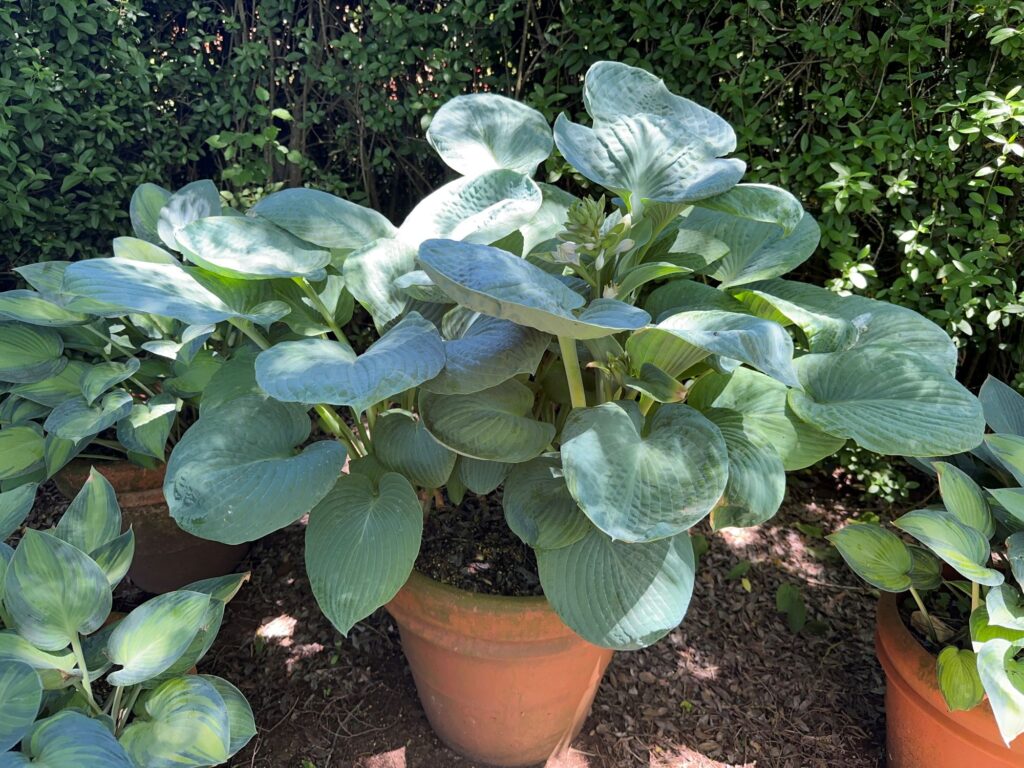Uncategorized
Hostas
It was around fifty years ago when I first visited Pirianda Gardens. At that time, it was the private garden of Harvey and Gillian Ansell. A place of extraordinary beauty and home to some of the most marvelous temperate climate trees such as a magnificent specimen of the dove tree, Davidia involucrata, a score or more different maples and a dozen species of birch to name a few. A fern gully and a small stream ran through the property. In one part the stream widened and was lined by masses of candelabra primulas and the giant Himalayan lily, Cardiocrinum giganteum, three metres or more tall towered over the scene. Beautiful though these were, I had seen them both before in other gardens. What was really astonishing to me were giant plants of Hosta sieboldiana var. elegans growing on mounds in the middle of the creek. Blue, deeply-veined leaves 30cm across combined to make giant clumps more than a metre wide. Sadly, we can’t all garden in fern gullies, and my attempts over the years to grow Hostas as garden subjects had disappointing outcomes to say the least.

My dear late sister Kathleen’s small London garden was open under British National Garden Scheme for many years. Under the scheme, “gardens of quality, character and interest” which are normally private, are open to the public. Whilst small, her immaculately kept garden was a haven from the dirt and bustle of modern London. My sister’s garden wasn’t a riot of colour. “Who wants a riot in the garden?” I remember her saying. She never missed a Chelsea Flower Show. Always visiting on the last day and waiting until the end when the displays were being pulled down so that she could buy, at a very frugal price, some treasure which she would carry home by train. Kathleen was not a fan of the Hampton Court Flower Show and was astonished that Criss and I were going to visit it. “But it smells of hot dogs,” were her words.
Kathleen loved to see other people’s gardens. There was a problem though. Whilst she had a car and a driver’s licence, she hated driving or being driven in the city of London. To overcome her phobia, my sister would take the train to a station in the closest town to the gardens she wanted to visit. One of her three sons would drive her car to that station and catch the train back to London. My sister would spend the day trundling around the English countryside visiting gardens, drive back to the station, catch the train back to London and home. Meanwhile, a long-suffering son would catch the train, pick up the car and drive it back to London.
Kathleen’s garden had a narrow, paved area on the east side of the house. There, in large terra cotta pots, were the most beautifully grown Hostas. None of the flamboyant gold variegated ones though, just different forms of the Hosta sieboldiana, including the giant blue leaved Hosta sieboldiana var. elegans, which I had seen years before at Pirianda.
I had struggled with growing Hostas in the garden as they didn’t like competition from the roots of other plants, nor were they tolerant of dryness. They are martyrs to the depredations of slugs and snails too. I don’t like to throw snail killer around the garden as small birds are likely to eat the bait.
Twenty years or so ago I was given a couple of plants of the variegated Hosta ‘June’ by a friend and at the same time Criss was given a plant of the giant Hosta sieboldiana ‘Big Daddy’ by the Friends of the Ballarat Botanic Gardens as a thankyou for opening an art show for them. When we got these three plants we potted them into large terra cotta pots. They are still thriving in those pots to this day.
Over the last year or two, as more varieties of Hosta have become available through the wonders of tissue culture, I’ve been able to make a grouping of ten potted Hostas of various varieties. I walk past the group each day, and each day it gives me much joy.

